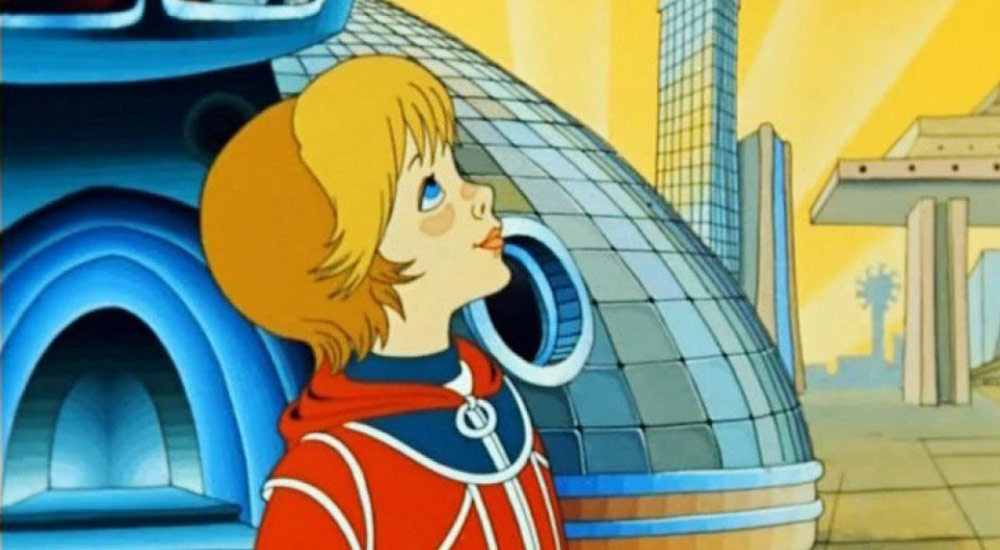
In the previous series: we compiled a
selection of Soviet cartoon science fiction. We collected comments about those cartoons that were not included in the first part - and are talking about them now.
1924: The Interplanetary Revolution
This is an unusual creation at the junction of Russian avant-garde and propaganda poster. Nowadays, a cartoon looks like a work of contemporary art. The plot is simple: the frightened bourgeois fly into space to escape from the angry proletarians. The proletarian ship catches up with them, the world revolution triumphs in space.
This cartoon was painted and animated in the "Nepman's" studio Mezhrabpom-Rus and the State College of Cinematography, now known as VGIK. The authors are artists Nikolai Khodataev, Zenon Komissarenko, Yuri Merkulov and unnamed students.
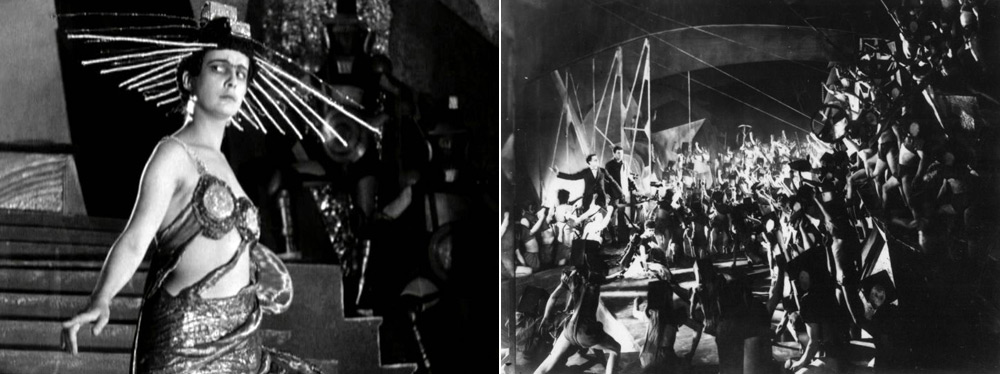 The film "Aelita"
The film "Aelita"Initially, the "Interplanetary Revolution" was conceived as an animated insert in the classic silent film "Aelita" by Yakov Protazanov. The director abandoned the pioneering venture at the last moment. Multipliers completed the work and released an independent work.
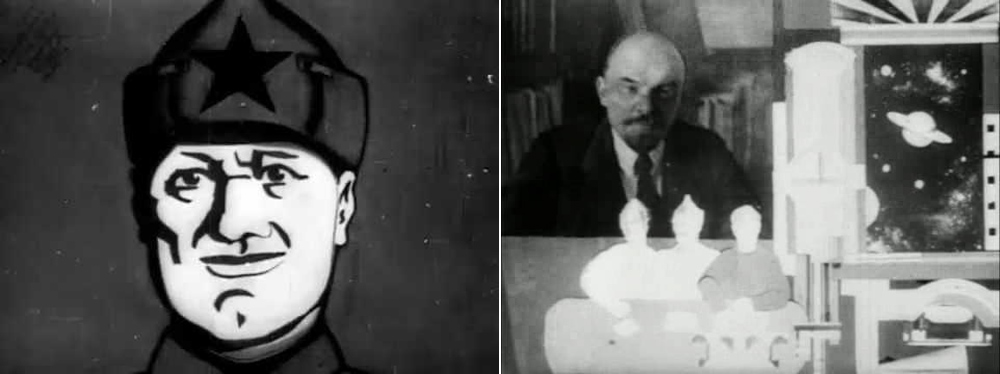
At the end of the cartoon, a photograph of Vladimir Lenin appears for a few seconds. He died a few months before the premiere.
Cartoon suggested
oracle_and_delphi .
1953: Flight to the Moon
This children's cartoon was shot eight years before the flight of Yuri Gagarin into space, and four years before the "official" start of the space race. “Flight to the Moon” tells how the pioneer Kolya Khomyakov went to the earth’s satellite with a “hare”. A young traveler helps professor of astronomy Bobrov and female cosmonaut Sofya Andreevna find the missing expedition.
Fyodor Khitruk, the future director of the animated films “Winnie the Pooh” and “Film, Film, Film”, participated in the work on “Flight to the Moon”.
Flight to the Moon seems like a remake of the 1935 Space Flight movie. In a dumb, black and white tape, the Joseph Stalin rocket plane flies to the moon to find a missing rocket with a cat. A schoolboy makes his way to the ship; the cat is being rescued. Space Flight scriptwriters were advised by Konstantin Tsiolkovsky. In the cartoon, Russian Kolya, a black boy Sandy, and Ukrainian Petya form the “Tsiolkovsky International Interplanetary Communications Society”. In both paintings, the spacecraft will start from the flyover, and the expedition commander is a stern bearded old man.
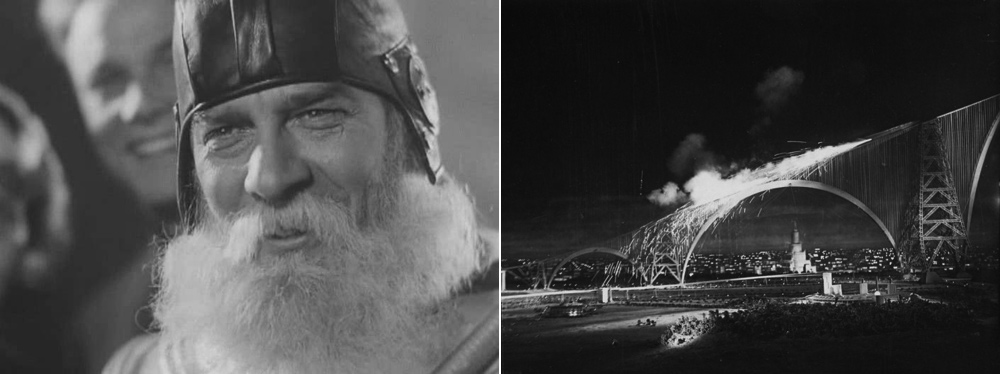 C / f "Space Flight"
C / f "Space Flight"The cartoon is drawn in the "naturalistic style" characteristic of the Soviet animation of that era. Other signs of time are also visible. The panorama of Moscow with the Stalinist skyscrapers and the Palace of Soviets is shown (it was never erected).
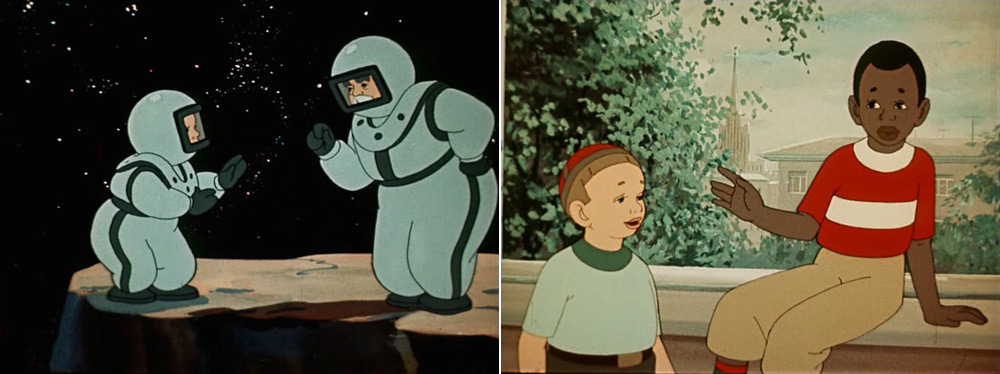
Cartoon suggested
eandr_67 and
u007 .
1972: "Phaeton, son of the sun"
"Phaeton" is a "hypothesis film." So he was dubbed the director, famous actor Vasily Livanov. A 16-minute drawn film mixes a sci-fi story with philosophy and mythology. It is designed for adults and thoughtful teens.
In the distant future, the Phaeton-1 ship is heading for the asteroid belt between Mars and Jupiter. The astronauts should land on the asteroid Ceres and check the assumption that cosmic stones are the split planet Phaeton. The versions of a space catastrophe are described: the war of a highly developed civilization, the attraction of Jupiter, a collision with a comet.
In parallel, the legend of Phaeton, the son of the god Helios from ancient Greek mythology, is told. The phaeton asked his father for permission to ride a sun chariot (to prove kinship - this is not mentioned in the film). The inept driver did not cope with the horses and scorched the Earth. The goddess Gaia prayed for help, and Zeus struck Phaeton with lightning.
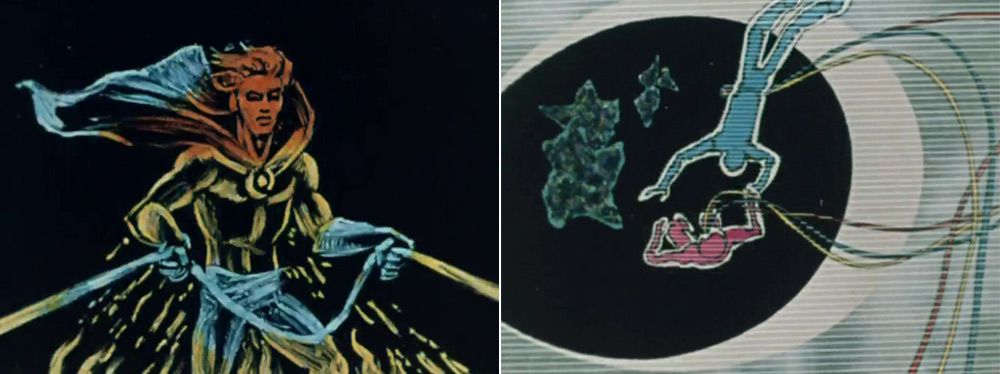
There are errors in the movie. In the beginning it is said that the distances of the planets from the sun are called arithmetic progression. In reality, the formula is more complicated (this is the
“Titius-Bode rule” ). There is a confusion with historical details - the god Helios is depicted as an ancient Egyptian pharaoh. Nevertheless, the wonderful cartoon turned the eyes of many viewers up to the mysterious sky.
Cartoon suggested
ar1ur .
1973: The Miracle
The artist and director Anatoly Petrov ended up in our previous selection with the 1977 Polygon cartoon. The creator's characteristic realistic style began to take shape earlier - and is already visible in the cartoon “Miracle” from the “Merry-Go-Round” almanac.
The plot of “Miracle” is based on the eponymous poem by Roman Sef. In the hand-drawn version, two children run through the “cyberpunk” city of the future to look at a live sprout. The city is devoid of greenery and filled with cars, but does not look dead. It is a dynamic and vibrant environment, and the faces of children are expressive. The ending is spectacular due to the atmosphere: the sound and speed of the events taking place on the screen change.
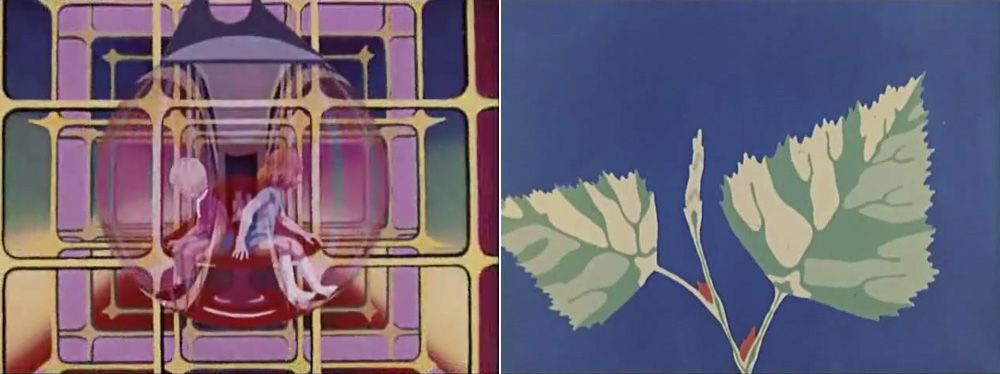
Together with Petrov, the animated artist Ada Nikolskaya, composer Shandor Kallosh, cameraman Mikhail Druyan and sound engineer Vladimir Kutuzov worked on the cartoon. A small team, and in the cartoon only two minutes - but these are two minutes of pure art.
Cartoon suggested
agp88 . According to
FRAGIL3 , three seconds are cut from the “Miracle”, which shows that the city is in the desert.
1981: The Secret of the Third Planet
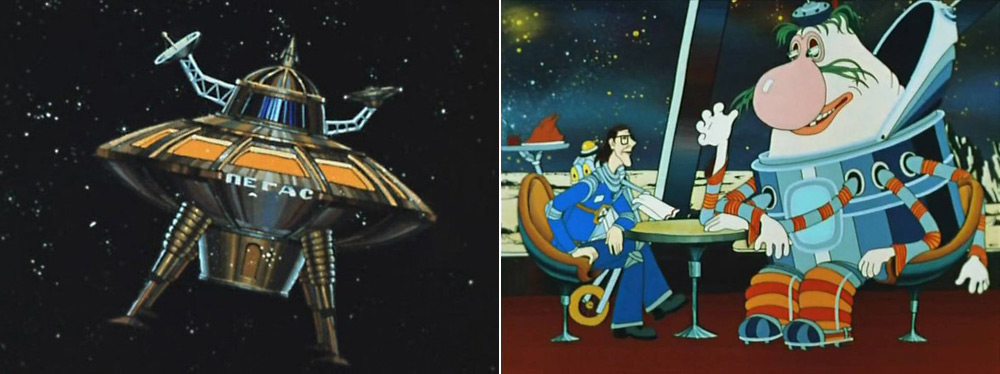
This is a classic film adaptation of the story of Cyrus Bulychev "Alice's Journey". Captain Zeleny, Professor Seleznev and his little daughter Alice set off on a space expedition. The goal is to find animals for the Moscow Space Zoo. Together with the beasts, the company finds lost captains-travelers and their enemies - space pirates. The plot of the cartoon is almost no different from the book, but the action was transferred to the XXII century from the XXI century.
The full-length 48-minute cartoon is made using the traditional hand-drawn animation technique. For the director Roman Kachanov, this was the fourth film drawn, before that he was engaged in puppet animation. Artist Natalya Orlova sketched Captain Zeleny from her husband, and the main character from her daughter. Therefore, Alice in the cartoon does not look like a father professor. Because of this, there are different theories among the fans about the relationship of characters.

Kachanov, Orlova and Bulychev received the USSR State Prize for this work. The main award was the love for the cartoon of many generations of viewers, including those who were born decades after the premiere.
Cartoon was the first to suggest
geher .
Video - a remaster, which was performed by the user of Habr slimper.1984: The Meeting
Mikhail Titov and the Kievnauchfilm studio got into the previous selection with the cartoon “The Battle” based on the story of Stephen King. The “meeting” was shot according to the original script. The technique of "total animation" is applied: backgrounds move along with the characters. The time-consuming and complex method conveys the dynamic movement of the camera.
In the “Meeting” phantasmagoric scenes appear. An alien flies into an abandoned hut in the Soviet outback to talk with local earthlings about UFOs. He pretends to be Jean-Paul Belmondo, drinks moonshine and smokes "Cosmos" with a local fisherman. The fisherman turns out to be an alien, like a plastic doll lying in a hut.
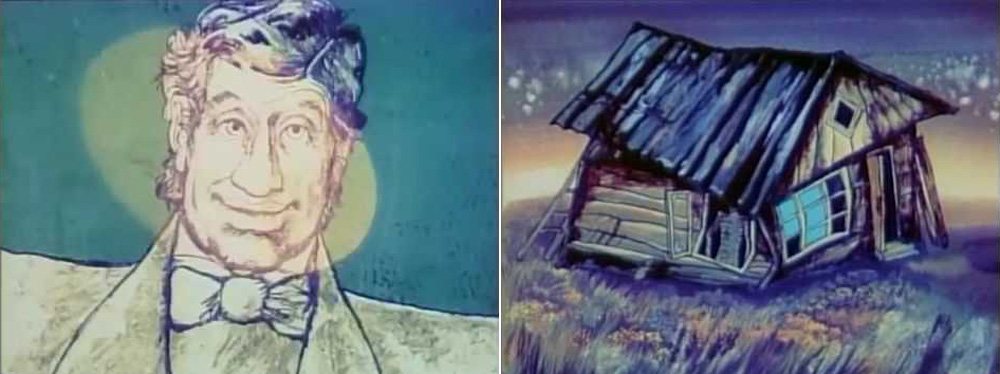
The cartoon combines satire, fiction and mystical motifs at the same time. The tossing camera seems to be chasing not for the characters, but for the internal demons, tearing apart the society of those times.
Cartoon suggested
vitalyvitaly .
1985: “From the diaries of Iyon the Pacific. Journey to Interopia »
Director Gennady Tishchenko created colorful cartoons "Vampires of Geona" and "AMBA". But he began with the classics: his thesis was the film adaptation of the story from the series “Star Diaries of Iyon the Quiet” by Polish writer Stanislav Lem.
The Fourteenth Journey is known even to those who have not read Lem by the mysterious sepulchi. What is a sepule?
Sepulka is an important element of the Ardrit civilization. See SEPULARIUM.
Sepulcarium is a place for storing sepules and sepulia. See GRIP.
Sepulation is an occupation of arthritis from the planet Interopia. See SULPS.
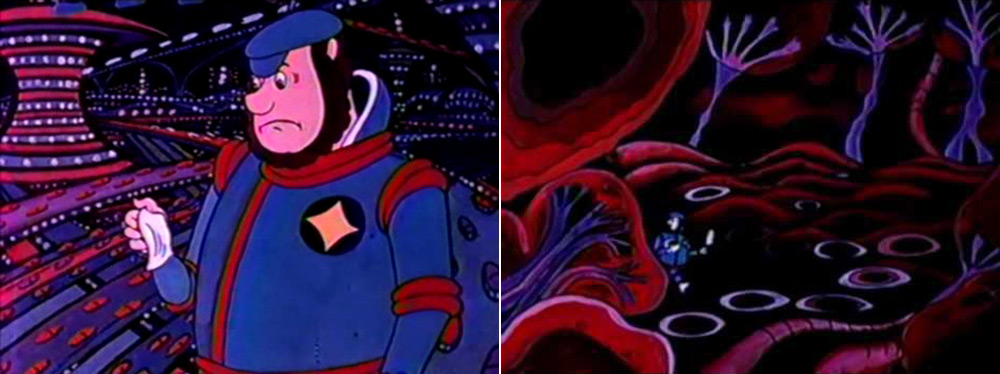
The translation in the cartoon is slightly different from the usual book. Events are shortened: space explorer Iion the Quiet flies to the planet Interopia to hunt Kurdle, a local animal. There it falls under a meteor shower. Unlike the original source, the hero learns from his own experience what sepules are. However, this is an interpretation of Tishchenko. Lem himself forgot what he meant by sepulchi.
The cartoon suggested
Exchan-ge .
1987: The Lesson
This adult cartoon is the work of the legendary Armenian director and animator Robert Sahakyants. He is loved for children's cartoons "In the blue sea, in white foam" and "Wow, talking fish." The prolific author left many other philosophical parables, including The Lesson.
A group of space hunters for entertainment landed on an unknown planet, covered with dense forests. Local nature aggressively does not tolerate emptiness. Everyone who kills the beast turns into this beast; a sawn tree becomes a tree. The only woman in the group watches how all her companions frivolously kill animals and are reborn. The huntress accidentally discovers that if the transformed is killed, the former form returns to it, albeit with bestial habits. She collects part of the group and flies away.
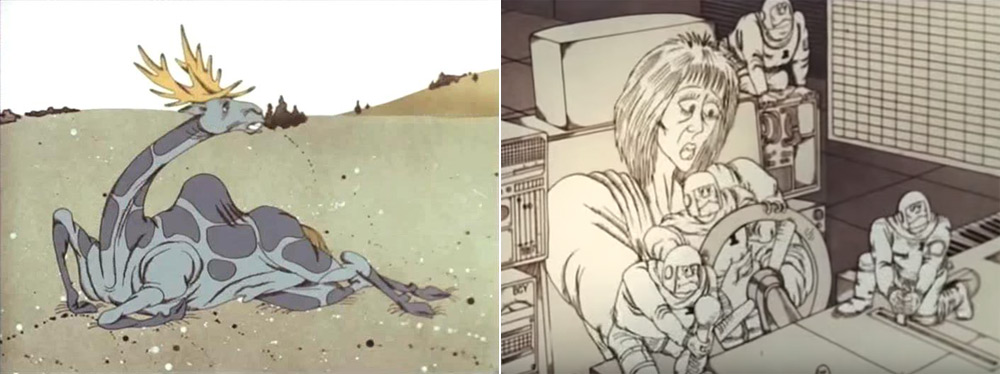
Western music sounds in the cartoon: composition “Rockit” by Herby Hanson, “Stalakdrama” by Yello, “Nightflight to Venus” by Boney M., “Equinoxe 5” by Jean-Michel Jarre and “Imagine” by John Lennon. Shamelessly shown nudity and hints of sex. Some see The Lesson as a hidden criticism of the Soviet regime.
Cartoon suggested
Tarson and
sashagil .
1988: The Wind
“Wind” is another bold work of Sahakyants with open criticism of militarism and the totalitarian system. 18 minutes without a word, they say that the madman who has reached the button turns himself and the world to dust.
The main character is a soldier on duty at a military base. Missiles take off from the base. The attendant continues to check the gaps at the entrance and notices that something strange is happening. Either one man’s hair is showered, or another’s tail grows. Meanwhile, the higher ranks fall into madness, and the start button sticks. The officer responsible for launching the missiles uses drugs and arranges a nuclear apocalypse. The hero is trying to escape, but cannot - stairs and doors bring him back. Then the soldier breaks the window and jumps into the unknown. A radioactive wind kills the remains of the living at the base.
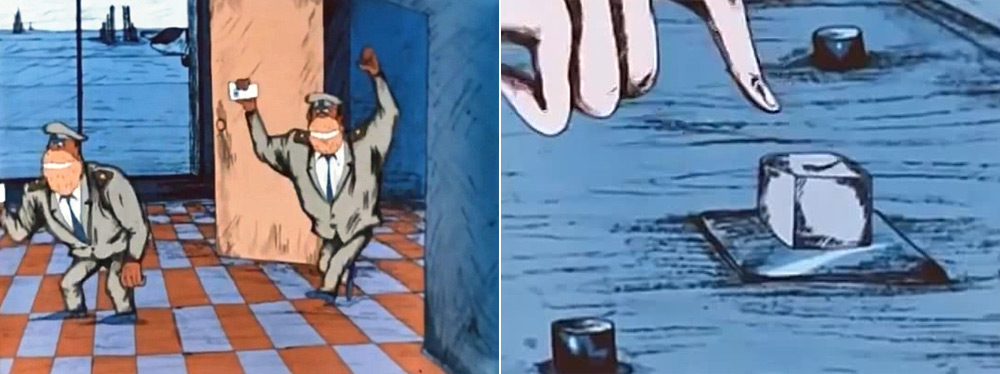
The military is deprived of humanity in the same way as the hunters in the "Lesson", turning into fantastic creatures and animals. Fans interpret the “Wind” as a retelling of the last years of the Soviet regime. The cartoon came out before the collapse of the Union - this is a prediction of the end.
Cartoon suggested
SvSh123 and
Shtucer .
1989. The Lost Galaxy
This is a short satire of the work of a creative couple: director Anatoly Solin and production designer Inna Pshenichnoy. They worked together on Bremen Town Musicians, Toddler and Carlson, and other popular cartoons.
The Lost Galaxy is based on the eponymous story by screenwriter Yevgeny Shatko, written in 1968. In the outback, a UFO lands with an alien who is eager to share knowledge with earth scientists. He is met by the forester Akimych and does not understand what he encountered. An alien gives the forester an artifact with a "concentration of philosophy and science" and flies away. Akimych bury a gift in the ground.
The black-and-white cartoon is made in the technique of “total animation”, both the backgrounds and the characters are moving. The Lost Galaxy was not easy to shoot because of the flicker effect.
Cartoon suggested
sanok .
1990: Once upon a time
At the end of the Soviet Union, they tried to reorganize Soyuzmultfilm studio, breaking it into five creative associations. The Tradition Association filmed the Once Upon a Time cartoon. The result was a beautiful science fiction fairy tale for children.
The plot is described by the phrase "The dragon slayer himself becomes a dragon." The bride and groom live in a futuristic city. A huge steel dragon robot approaches the city, the townspeople sacrifice the girl to him. The hero puts on armor, catches up with the car and kills its owner. It turned out that the kidnapped woman was alive, but during the time of separation she fell in love with the kidnapper, so she pierced herself with a sword. The new dragon master takes off his armor and returns to the city.
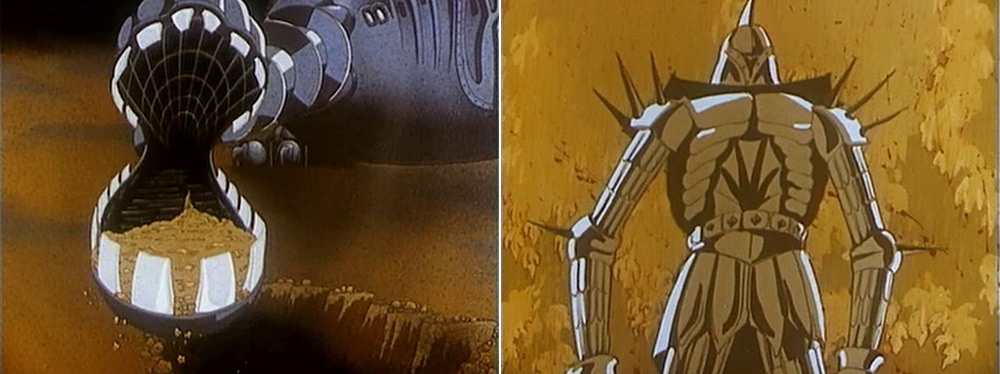
Star Wars had an unexpectedly strong influence on painting artists. The city is located in the Tattoo desert, swords are light, and the armor is similar to the armor of Darth Vader. The insides of the dragon machine resemble the Death Star. The most obvious hint is hidden in the narrator's words: “At one distant time, it is impossible to understand whether this was in the distant past, or will be in the distant future ...” Only the opening credits are not enough.
Cartoon suggested
sashagil .
We hope you don’t forget anything else! If your favorite Soviet hand-drawn science fiction still did not make it to the selection, be sure to write about it in the comments. Enjoy your mammal!

